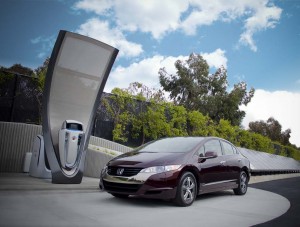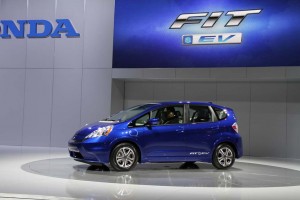Honda took the wraps off its first battery-electric vehicle, the2013 Honda Fit EV, which will roll into showrooms in select markets next summer.
But the Japanese maker, an early pioneer in hybrid technology, is clearly not ready to plug all its eggs into one electric basket. While it will expand its battery car efforts, company officials stress they’re not walking away from other alternative powertrain solutions – which range from natural gas to hydrogen, as well as even cleaner gasoline engines.
“We don’t know if the answer is electric or hydrogen or natural gas,” cautioned Mike Accavitti, the maker’s U.S. marketing chief, “so, at Honda, we’re working on all of them.”
Honda has opted for a lease-only approach for the Fit EV, the base car planned to carry a $399 monthly charge based on an estimated $36,625 MSRP.

Honda has set up a solar-powered hydrogen refueling station near Los Angeles for the maker's FCX Clarity hydrogen fuel-cell vehicle.
The 2013 Honda Fit EV is a lithium-ion-powered version of the maker’s current subcompact model. It’s equipped with a 20 kilowatt-hour battery pack that the maker claims will give it a range of up to 123 miles in urban driving – where it can regenerate energy like a conventional hybrid. Mileage will be less on the highway, however, and the maker projects a combined-cycle range of just 76 miles.
Those numbers will dip further in colder climes as an owner turns on the car’s heater. And that may explain why Honda initially plans to make the Fit EV available only in select markets, starting with California and Oregon next summer. Dealers on the East Coast will get the car in 2013.
That’s a similar strategy to what Nissan used for the roll-out of the Leaf battery-electric vehicle, or BEV, as did Chevrolet with the launch of the Volt. But they’re both on a path to nationwide availability. Honda has announced no plans to go nationwide with the Fit EV, however.
That perhaps underscores the maker’s admitted skepticism about battery power. Though it was the first to launch a hybrid-electric vehicle in the U.S., the original Honda Insight, it has been slow to enter segments of the market using more complex battery propulsion systems. It has yet to market a true full hybrid capable of running on battery power alone for at least short distances – like the popular Toyota Prius. But Honda does plan to introduce a longer-range plug-in hybrid.
Meanwhile, it is still touting its hydrogen fuel-cell program, which developed the FCX model that has been leased to a small cadre of customers in Southern California.
Another one of Honda’s alternate power efforts was honored with the annual Green Car of the Year award during the L.A. Auto Show. It recently launched a natural gas-powered version of the 2012 Honda Civic and intends to double the volume of the old model – though that will still only reach about 2,000 units a year.
The maker hasn’t said what its sales targets are for the Honda Fit EV but based on initial demand for the Nissan Leaf and Chevy Volt – and the limited number of markets the Honda battery-car will be sold in, the numbers aren’t likely to be much bigger than those of the Civic natural gas model.
Alternate power is “more than a slogan for Honda,” insisted marketing czar Accavitti, but in terms of its collective impact on the maker’s volume, it’s still just an asterisk on the sales chart.

